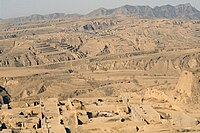
Photo from wikipedia
Abstract Chinese loess deposits preserve abundant information on the aridification of the Asian interior and Asian monsoon evolution during the Quaternary. Although substantial progress has been made in deciphering the… Click to show full abstract
Abstract Chinese loess deposits preserve abundant information on the aridification of the Asian interior and Asian monsoon evolution during the Quaternary. Although substantial progress has been made in deciphering the paleoclimatic record of the thick loess deposits in the western Chinese Loess Plateau (CLP), the environmental significance of variations in the magnetic susceptibility (χ) and the ultrafine ( 40 μm fractions) of the 416-m-long Xijin loess core from the Lanzhou Basin, northeastern Tibetan Plateau. Our results indicate that the 40 μm fraction and marine oxygen isotope record. Consequently, we conclude that the pedogenic component is a more accurate and sensitive indicator of weathering and soil formation than the χ record, and it is well suited to reconstructing high-resolution Quaternary climatic change in the western CLP. Furthermore, the proportion of the pedogenic component increased systematically over the past 2.2 million years, which may have been primarily caused by long-term global cooling since the Early Pleistocene together with the episodic uplift of the Tibetan Plateau.
Journal Title: Journal of Asian Earth Sciences
Year Published: 2019
Link to full text (if available)
Share on Social Media: Sign Up to like & get
recommendations!